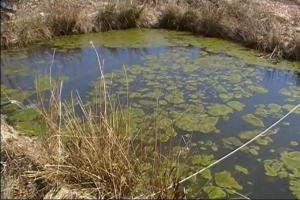 Problem Pond, let’s look into the future and understand what will happen. If you already have a pond learn how to save it now…
Problem Pond, let’s look into the future and understand what will happen. If you already have a pond learn how to save it now…
A Problem Pond will fill in over time if left alone to nature . The filling in process can take many years as leaves blow into the pond, fish waste, geese waste and weeds that may have been killed with chemicals. This filling in does depend on the size, depth and the amount of nutrients that enter the pond. Other ways of nutrients getting into the pond is simply rain, snow and from the 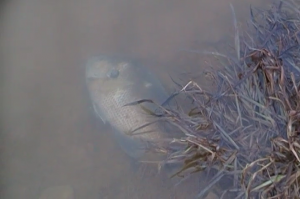 watershed where grass clippings, bird waste, fertilizer and whatever else from the watershed that flows into the pond bringing in these nutrients. So you see this will happen over time and the first thing to come up from the waste at the bottom of the pond is algae from all the nutrients. So look at it as everything that gets into the pond ends up at the bottom, filling it in slowly and continuing its journey to the grassy field it once was. Then there are more noticeable Pond problems like fish kills, bad odor, weeds and muck.
watershed where grass clippings, bird waste, fertilizer and whatever else from the watershed that flows into the pond bringing in these nutrients. So you see this will happen over time and the first thing to come up from the waste at the bottom of the pond is algae from all the nutrients. So look at it as everything that gets into the pond ends up at the bottom, filling it in slowly and continuing its journey to the grassy field it once was. Then there are more noticeable Pond problems like fish kills, bad odor, weeds and muck.
Problem Pond cross section shows 3 different thermal layers. The first top layer is the warmest, allows the sunlight to penetrate and has the most amount of oxygen. Then the second layer is a little darker, a li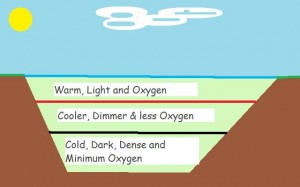 ttle cooler and less oxygen. Finally the last and deepest layer is dark, dense, cold and has very little oxygen. This bottom layer is so dense that chemical treatments can’t penetrate, fish can’t survive in it and is where the pond starts to fill in due to the lack of oxygen to break down the decaying matter. Now we really don’t want to use or rely on chemicals as they only prolong what will happen again, kind of putting a bandage on but over time it will fall off and need to apply again. What happens when these dangerous chemicals become outlawed?
ttle cooler and less oxygen. Finally the last and deepest layer is dark, dense, cold and has very little oxygen. This bottom layer is so dense that chemical treatments can’t penetrate, fish can’t survive in it and is where the pond starts to fill in due to the lack of oxygen to break down the decaying matter. Now we really don’t want to use or rely on chemicals as they only prolong what will happen again, kind of putting a bandage on but over time it will fall off and need to apply again. What happens when these dangerous chemicals become outlawed?
Problem Pond remedies can be accomplished in two different ways, with a pond fountain or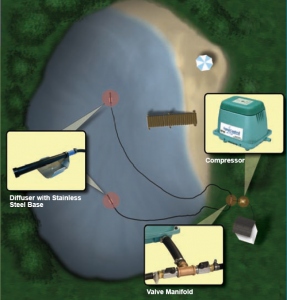 bottom diffused pond aeration. The bottom diffused aeration is where air bubbles are used to lift the bottom layer of water to the surface, the coldest darkest layer is raised to the surface to release the bad stuff, gasses and nutrients then soak in oxygen. As the cycle continues the pond will circulate from bottom to top making only one layer in the pond. Now the pond is completely aerated from top to bottom and can support more fish as they can now reach the depths of the pond and the bottom decaying muck can be broke down since oxygen is present.
bottom diffused pond aeration. The bottom diffused aeration is where air bubbles are used to lift the bottom layer of water to the surface, the coldest darkest layer is raised to the surface to release the bad stuff, gasses and nutrients then soak in oxygen. As the cycle continues the pond will circulate from bottom to top making only one layer in the pond. Now the pond is completely aerated from top to bottom and can support more fish as they can now reach the depths of the pond and the bottom decaying muck can be broke down since oxygen is present.
Typical decorative fountains will only do a few inches, possibly a foot deep of circulation and aeration. So be careful when you purchase a fountain for your pond. With a fountain there is the same type of circulation happening in the pond like the bottom diffused aerators. The main difference is water is pulled from the depths and exposed to the atmosphere from a couple feet to 100 feet high depending on the horse power of fountain and display head you choose. The toxic gasses are released and oxygen is splashed back into the pond. Again be sure to choose the right pond fountain.
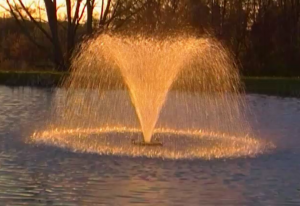 Problem Pond Remedies can also include Pond Blue which is a dye and Pond Bacteria that is specially formulated microbes that eat up the nutrients and muck that form at the bottom of the pond, but only where oxygen is present. Both of these are completely safe for the pond, wildlife, pets and us two legged creatures.
Problem Pond Remedies can also include Pond Blue which is a dye and Pond Bacteria that is specially formulated microbes that eat up the nutrients and muck that form at the bottom of the pond, but only where oxygen is present. Both of these are completely safe for the pond, wildlife, pets and us two legged creatures.
You can also learn the complete details about what is happening below the surface of your water at My Pond Aeration by video and a MP3 download Pond Management so get started now in curing your Problem Pond or save it before it even starts.

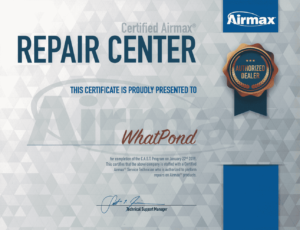
I am about to put in my first pond, assuming I get approval from the town on August 5. I am THINKING I will put the aerator in my house and run the pipe down to the pond which is about 200 feet away. Does any one have any experince with this. any recomendations on how to install.
Many Thanks
John
Hi I live in charlotte n.c. I have a pond approx 3/4 of an acre large and about 10 ft deep. It started to get a lot of grass in it this year so I put a sump pump down in it and made a fountion head for it It seemes to be helping to clean the top 12 to 18 inchs of the pond . I also put in some grass carp to help control the grass do I need to place the pump at the deepest part of the pond to get the best results? also I am only running the pump about 10 hours a day should I run it longer? Thankyou
Good move on adding the grass carp, I like doing that rather than using chemicals.
You are started in the right direction by getting the water moving in the pond and yes pushing up from the deepest depth would be best. Don’t start running the pump full time from the deepest depth as there should be a start up procedure so we’re not pushing all the non oxygenated water and toxic gasses up and into where the fish are, just a little each day to help send the toxic gasses to atmosphere. Also check out Aerator startup
.
I’m not too sure on the size of sump pump being used, how many gallons per hour it moves. But the goal is to turn the entire volume of water over at least once a day.
With a quick calculation on the pond size you have given and found approx. 1.9 million gallons of water in the pond, depending on what the slopes are and the shape of the pond. Moving water is more costly than moving air. Here’s an example of the AM30 bottom diffused aeration system, with the diffuser placed at the 10 depth. The diffuser can move 3,390 gallons of water per minute with air, turning over the entire pond volume twice a day so it could just be run 12 hours at night if you wish to. The compressor is a ¼ horse and piston type.
Using a sump pump say a ¾ horse with the 10 foot lift would provide 2700 gallons per hour of water movement. Adding the spray nozzle would choke the flow down some but even running at full bore for 24 hours would only provide 65,000 gallons of water movement using a ¾ horse sump pump.
I have a blog post called Summer Fish Kill that has more information as well.
Hope this helps
Darrell
We have a 3/4 size pond. We use to have tons of minnows last year. This year there is none. Where did they go?
Hi Dana, I’ve noticed the same thing happen in recent years, all summer long, fall and winter there are minnows to be found then when spring come they seem to disappear. But he last couple years they also have come back.
A couple thing come to mind for the disappearing minnows. If you get cold winters the fish are slowed down due to the cold and not very active and the minnows seem to hang in the shallows of open water trying to soak up some sun.
Once the pond warms up they fish are hungry and the minnows start moving out to deeper water. So a lot of them could of been food or finding areas to do their own spawning.
Another observation is habitat whether it is natural or artificial the fish need habitat. A place to hang by where they have protection from the larger fish. Our first year adding flat head minnows they didn’t seem to last very long, didn’t see any the following spring either. Before we added more minnows we added artificial habitat and that helped a great deal.
Habitat can be anything that the small fish can hide near or in so they don’t get eaten. But it also works for the predator fish as ambush areas, survival of the fittest. I would try to stay away from adding trees since over time they will end up breaking down and become nutrients that create algae and weeds. Here is a post I did a while ago on fish habitat, https://www.whatpond.com/2009/12/fish-habitat/
And the latest easiest way to add habitat is from https://www.fishiding.com/ using recycled product to make the structures.
Hope this helps.
Darrell
Hi, I’m researching solutions for our local park’s 3 or so acre pond in southeastern PA that is suffering a significant algae problem this summer. It is stream fed and has an overflow pipe, but clearly needs more flow. There is a limited budget as its a non-profit municipal authority that runs the park… What is better- adding an aeration blower or a sonar system algae zapper? Does it pay to add either when there is an existing problem or should we wait to install next season before the algae hits? Thanks.